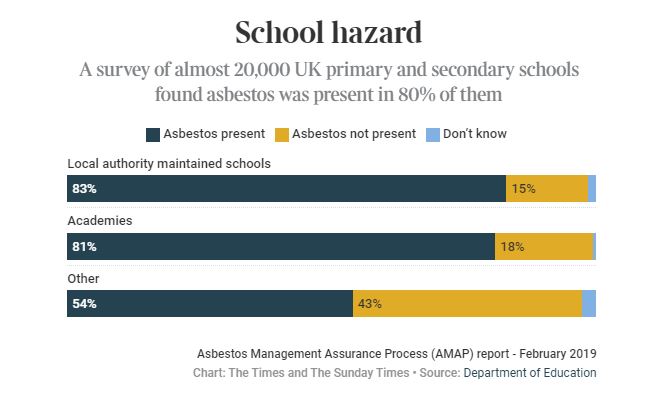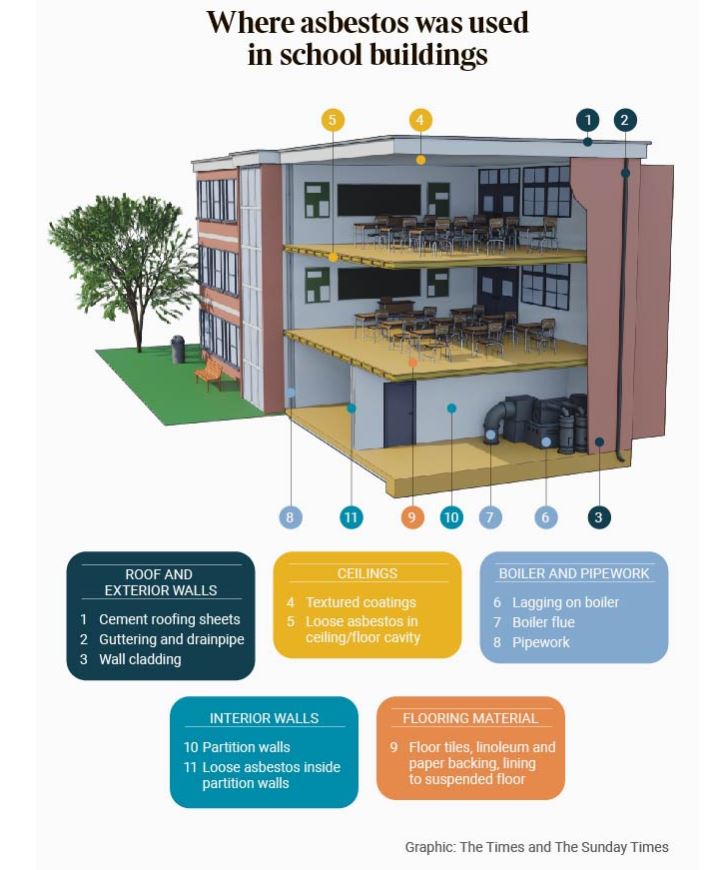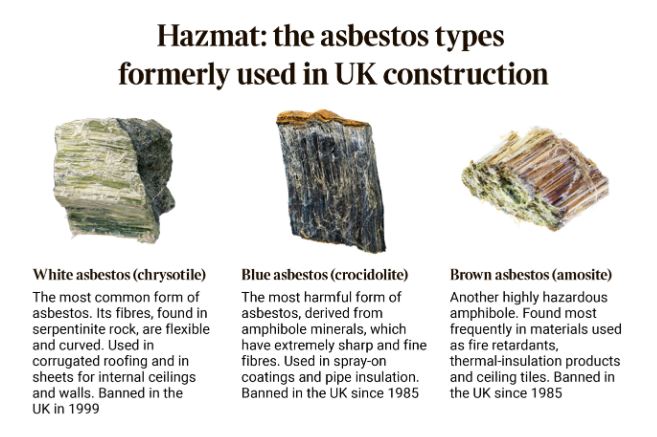Schools constructed pre the year 2000 in the UK, but especially, in the high-risk period (the 1950’s – 1980’s), commonly contain asbestos construction components. The life expectancy of asbestos containing materials in a well-managed building with a compliant maintenance inspection regime is in excess of 70 years.
Chris Willis was just 29 when doctors told him he probably had only a year to live because he had been exposed to asbestos as a schoolboy. “You don’t expect to go to school, get an education and come out with what I’ve got,” he said.
In February 2018, Willis, a PE teacher in London, was told he had mesothelioma, a cancer of the mesothelium, a membrane on the outside of the lungs, heart, intestines, and abdomen. There is no cure, although surgery and chemotherapy can extend life a little, and 60 per cent of patients sadly pass away within 12 months of diagnosis.
Last week the National Audit Office estimated that as many as 24,000 school buildings were beyond their initial design life, and of particular risk were 13,800 “system-built” blocks constructed between 1940 and 1980. Many of these contain asbestos.
Dangers of crumbling public buildings!
Asbestos is not a problem from a bygone age: more than 5,000 people a year are dying from diseases caused by it, primarily mesothelioma. And because of the length of the latency period before symptoms occur, some people exposed to asbestos in the last century may yet fall victim to it. Others will die of asbestosis — a hardening of the lungs — or of lung cancer.
Asbestos was banned in new buildings in the UK in 1999, and it’s estimated that approximately 20 million tonnes of building composite containing asbestos is still to be removed as waste.
There is no official figure for the number of schools containing asbestos. However, freedom of information requests and surveys by consultants and the Department for Education (DfE) have established that there are at least 21,500.
Asbestos is not toxic when left intact, but it can become dangerous when exposed or when buildings start to crumble or are renovated. Campaigners argue that, with so many public buildings in need of repair, the risk is growing.
A Department for Education survey in 2019 found that 81 per cent of state schools in England contained asbestos. In Scotland and Wales the figure is about 60 per cent. There are more than 32,000 schools in the UK, and any built before 1999 are likely to contain it. Among them are 12,000 “system-built” schools, based on lightweight steel and prefabricated designs with large amounts of asbestos. It was used as a fire retardant, insulation, pipe lagging, floor and ceiling tiles and panelling in walls and roof voids. The tiling would be made from chrysotile, or white asbestos, the inhalation of which can lead to asbestos-related illness. Much of the rest was amosite, also known as brown asbestos.
The HSE consider harsh brown asbestos fibre to be considerably more dangerous than white asbestos due to the proven risks of carpenters and joiners who specifically handled and installed this fibre. These workers installed AIB containing brown asbestos in the late 1950s, through to 1980, and consequently have the highest risk index to mesothelioma deaths when compared to all other construction-based trades. This AIB was used for fire protection in public buildings, especially schools.
Health and safety legislation does not require schools to inform parents about the presence of asbestos in schools, though some do provide parents with information to ensure them about effective management. Schools with asbestos are legally obliged to have a management plan.
Schools should be considered a special, high-risk environment due to their high-density occupancy, presence of youthful students, a historical under-funded building maintenance program, and potential for fire, vandalism, and damage to the building itself. Intact asbestos containing building materials pose no risk to the occupants, but those materials which have been impacted and disturbed have potential to release elevated levels of airborne asbestos fibre. Once airborne, asbestos fibres have potential to harm the building occupants which can lead to fatal diseases such as Mesothelioma and lung cancer.
Therefore, Duty holders of schools (those in charge of maintenance and repair) need to implement control measured to reduce this potential risk of exposure.
Are you ready to demonstrate your compliance to HSE Inspectors?
In 2023, the HSE announced that they will be targeting schools to see how they are managing asbestos in their buildings in accordance with Regulation 4 “Duty to manage asbestos in non-domestic buildings” of The Control of asbestos Regulations 2012.
To achieve this, the HSE will be proactively contacting schools to arrange asbestos inspection visits and to seek evidence of how the school is managing asbestos exposure on-site. Key documentation for inspection by the HSE will include:
- The asbestos survey and contained asbestos register.
- The asbestos management plan of the site.
- Asbestos training matrix for the maintenance and management team for the site – the school should be able to provide evidence of asbestos awareness training for maintenance staff and asbestos management training for senior maintenance and facilities staff.
We know from experience that most schools do have a good understanding of their duties to manage asbestos – but are you fully compliant?
With over 40 years of experience, Bardon Environmental provide a complete asbestos management & control service.
- We are offering a free compliance check to schools and academies across the UK, where we’ll establish if your current Asbestos Management Plan and Asbestos Register are compliant and in-date.
- We can update your Asbestos Survey Reports and offer Refurbishment/Demolition asbestos surveys of areas you may want to renovate in the coming months.
- As a Licensed Asbestos Removal Contractor, we can provide costs for any remediation works required.
- Asbestos Training – Providing UKATA-approved asbestos training courses, we can work with you to ensure your key members of staff have the right asbestos training, whether that be Asbestos Awareness Training (which requires a yearly refresher) or Management of Asbestos in Premises for senior management; we have a course to suit you.
To talk to someone about your FREE compliance check, or for help & advice, call our team on 0114 349 7400 or you can email us on [email protected].
Bardon Environmental – supporting the public and private sectors for over 40 years.





